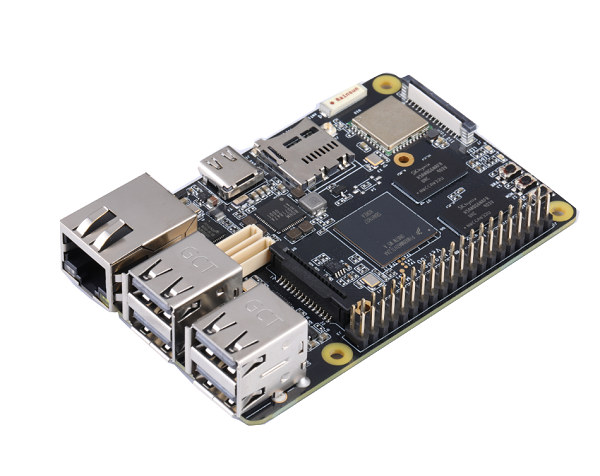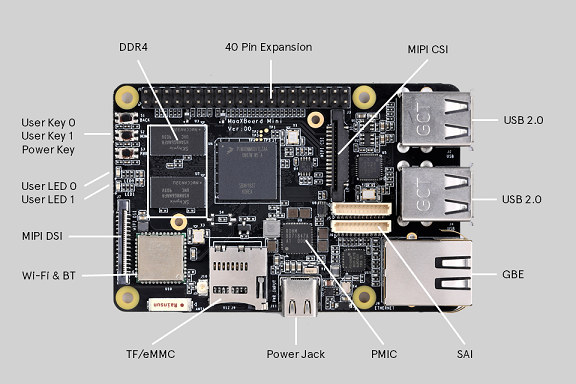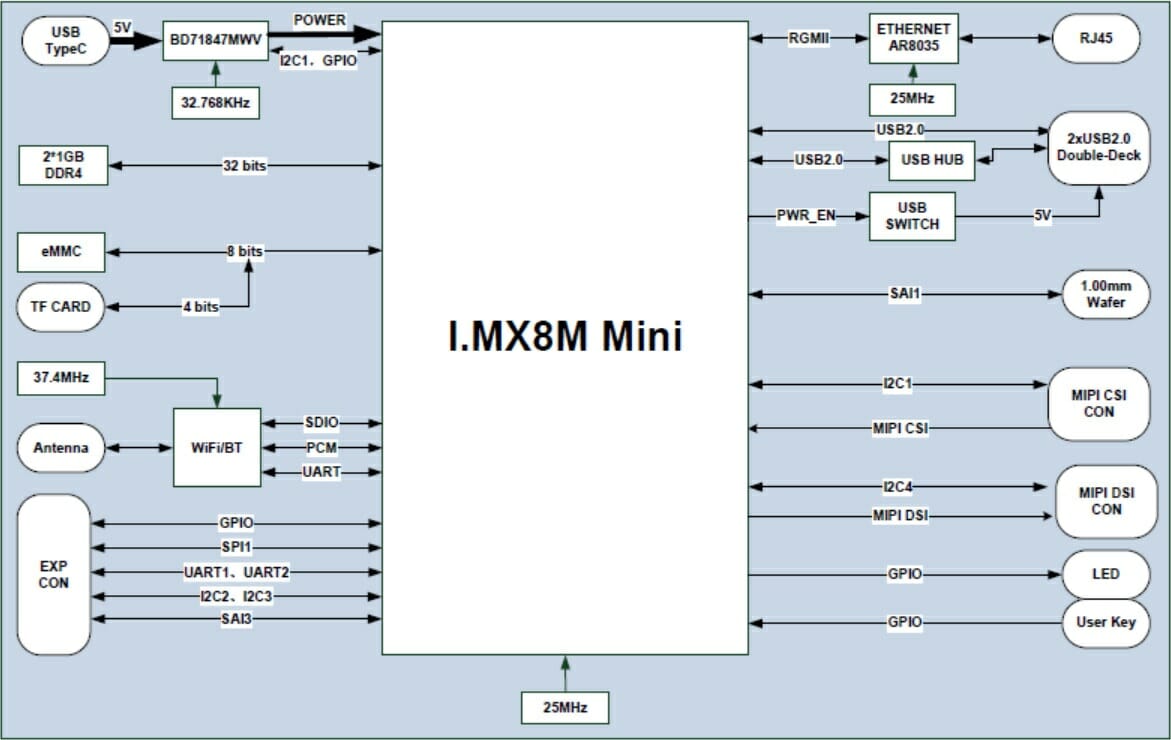Last year, Embest – an Avnet company – introduced MaaXBoard NXP i.MX 8M SBC mostly compatible with Raspberry Pi form factor and running Android 9.0 or Yocto Linux.
The company has now launched MaaXBoard Mini with a 14nm NXP i.MX 8M Mini quad-core processor. In some ways, the new board follows more closely Raspberry Pi 3 Model B form factor with four USB 2.0 ports, instead of the two USB 3.0 ports found in the first version of the board, but it does so without HDMI output, leaving MIPI DSI as the only option for display output.

- SoC – NXP i.MX 8M Mini Quad with 4x Arm Cortex-A53 cores @ up to 1.8GHz, Cortex-M4F real-time core @ 400MHz, Vivante GCNanoUltra 3D GPU and GC320 2D graphics, 1080p H.264/H.265 VPU;
- System Memory – 2GB DDR4
- Storage – eMMC socket for up to 64GB flash, MicroSD slot
- Display Interface – MIPI DSI
- Camera Interface – MIPI CSI
- Audio – SAI via GPIO connectors
- Connectivity
- Gigabit Ethernet port
- 802.11ac WiFi 5 and Bluetooth 4.2 with on-board ceramic antenna, u.FL connector for external antenna
- USB – 4x USB 2.0 host ports, 1x USB Type-C port for 5V power input only
- Expansion
- 40-pin Raspberry Pi-compatible GPIO header with I2C, SPI, UART, I2S, SAI, GPIO, etc.
- 8-bit and 7-bit GPIO connectors including one with SAI audio.
- Misc – Power and 2x user buttons, 2x user LEDs, heatsink
- Power Supply – 5V/3A via USB Type-C; PMIC and voltage regulators
- Dimensions — 85 x 56mm
- Temperature Range – 0 to 70°C
- Certifications – FCC, CE and RoHS

MaaxBoard Mini supports Yocto built Debian 10 and Android 9.0 images with Linux 4.14.98 kernel, as well as Windows 10 IoT Core operating system.
The board targets Human-Machine Interaction (HMI) solutions, family entertainment, building automation, education, machine vision, medical imaging, and generic embedded computing platforms.
MaaxBoard Mini SBC is available now for $72.50 on Avnet or Embest store. More details may be found about the product page that also links accessories to such a MIPI CSI Camera Module, a MIPI DSI display, and Monarch Go Pi HAT adding LTE Cat M1 cellular connectivity to the board.
Via LinuxGizmos

Jean-Luc started CNX Software in 2010 as a part-time endeavor, before quitting his job as a software engineering manager, and starting to write daily news, and reviews full time later in 2011.
Support CNX Software! Donate via cryptocurrencies, become a Patron on Patreon, or purchase goods on Amazon or Aliexpress






how can this be twice as expensive while being much slower than rpi4? And no usb3 either.
Because using a higher-quality, well-documented SoC that doesn’t come with blobs and which has good mainline support tends to take much more time to integrate cleanly than some opaque stuff you can simply solder on a board without the fear that anyone could see where you saved time and cut costs. In addition, note that we’re talking about a more modern 14nm chip, which is 4 times smaller than the 28nm one in the rpi4, hence will likely not even require a heat sink at all, contrarily to rpi3/rpi4. IMHO, the board design looks clean, and having anticipated the need… Read more »
I have previous version of MaaXBoard and it needs heatsink. And there is no 3D support for such GPU. No HDMI port means you have to buy LCD panel and the price is much more expensive…. Compare to the RPi4 my opinion Rpi4 win Cortex A72- to Cortex A53 and better GPU support
There is Etnaviv in mainline kernel and in Mesa for Vivante GPU.
Don’t know how much it is supported, there is not so much documentation. At least the current 2D GPU is supported, Somes Vivante GPU have 3d support (how much ?).
https://github.com/etnaviv/etna_viv
Not everyone needs a screen, especially in industrial there are many headless systems.
And if a display usually its not an hdmi tv, but an lcd panel maybe even with resistive touch (think i.e. gloves).
“In addition, note that we’re talking about a more modern 14nm chip, which is 4 times smaller than the 28nm one in the rpi4, hence will likely not even require a heat sink at all, contrarily to rpi3/rpi4.” It…. Doesn’t really work like that. 14nm node does not mean the chip is 4x smaller. First, marketing node size means absolutely nothing these days, as every foundry measures it differently. And secondly, because you’re comparing two wildly different chips, you cant really say one is 4x smaller, just because it uses smaller fab. And lastly, a smaller fab does not automatically… Read more »
No one I know of would without any need design a new board from scratch, if also a som is available and your design can focus on a baseboard.
Don’t underestimate the costs (=time) of designing a working board with all the impedance controlled bus lines like ddr memory and such things.
Just to grasp an impression about the difficulty to design such boards, read olimex’ blog about their olinuxino boards.
No HDMI port makes it extremely limited, regardless of how puritanical the hardware is.
I’ve seen quite a number of people deploy SBCs in field for monitoring purposes (hence no need for HDMI there). They just need “satellite” probes at various places in their customers infrastructures, running ping and contacting local agents to collect metrics, occasionally serving as an SSH bounce point or serial port master. That’s typically a use case where you want something more reliable than the average RPi and more future-proof than the usual alternatives (with a notable exception for hardkernel who maintains their devices for a long time).
I read such pricing comments frequently with a lot of different boards – is it really that hard to understand that production volume affects pricing? The RPI is made in the hundred thousands or even Million pcs / year. This board (and almost all others) is maybe made in 1.000 pcs volumes. That is a hughe difference.
Plus the technical differences of course, the i.MX is designed for industrial / automotive applications.